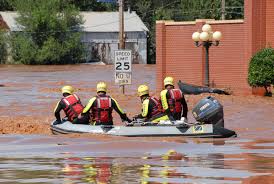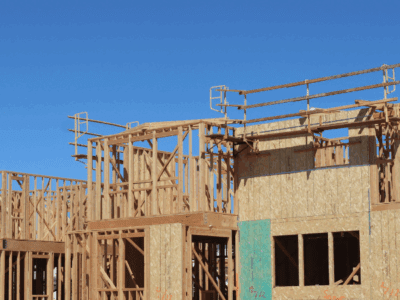Louisiana Flood Lessons for a Climate-Changed Future
Louisiana’s preparedness for a 1000-year flood, and implications of the slow media response for slow-onset climate impacts
The devastating floods in southern Louisiana a  week ago left at least 13 people dead, tens of thousands in need of rescue, and 60,000 homes damaged. In one parish, nearly ninety percent of homes flooded. Cellular network failures, road closures, power outages, and sewage-contaminated floodwaters continue to threaten relief efforts. The American Red Cross is likely to give out 1.2 million meals in response to what it has said is the “worst disaster to strike the United States since Superstorm Sandy.”
week ago left at least 13 people dead, tens of thousands in need of rescue, and 60,000 homes damaged. In one parish, nearly ninety percent of homes flooded. Cellular network failures, road closures, power outages, and sewage-contaminated floodwaters continue to threaten relief efforts. The American Red Cross is likely to give out 1.2 million meals in response to what it has said is the “worst disaster to strike the United States since Superstorm Sandy.”
As Louisiana communities move from immediate disaster response to the lengthy recovery process ahead, two questions come to mind: To what extent could this disaster have been mitigated? And has the response been adequate? It will be months and maybe years before in-depth analyses sufficiently answer these questions. Initial news reports, however, offer glimpses of ways the region could have better prepared for this 500 to 1000-year flood, and raise concern about future responses to climate impacts.
To what extent could the disaster have been mitigated?
Early reports about the flooding indicate that Louisianans were caught largely unaware. Some residents blamed the lack of early warnings about the upcoming rainstorm for their failure to implement storm precautions like moving cars to higher ground. But weather forecasters had warned of heavy  rainfall and issued flood warnings for the region. Perhaps these warnings did not adequately signal the extent of the rainfall and potential flooding. And residents would likely struggle to predict what extra precautions were necessary in preparation for unprecedented levels of rainfall. After all, most did not expect floodwaters to reach homes on high ground.
rainfall and issued flood warnings for the region. Perhaps these warnings did not adequately signal the extent of the rainfall and potential flooding. And residents would likely struggle to predict what extra precautions were necessary in preparation for unprecedented levels of rainfall. After all, most did not expect floodwaters to reach homes on high ground.
If this were truly a 1000-year flood, its low likelihood of occurrence might explain the lack of anticipation or preparation for its impacts. But recent studies linking climate change to increased frequency of heavy rainfall events suggest that what used to be a 1000-year flood may already be increasingly common. For instance, the National Academy of Sciences released a report this year that noted an “array of studies [providing] strong support for upward trends in the intensity and frequency of extreme precipitation events.” In that case, Louisianans and other coastal communities should not rely on historic flood frequencies in preparing for future floods. Rather, local preparations should ensure that residents anticipate and understand how to respond to increasingly frequent high-intensity rain events. This is also consistent with FEMA’s requirement that state hazard mitigation plans consider changes in frequency of extreme events due to climate change.
The Mayor of Walker, Louisiana, also blamed poorly planned infrastructure. In fact, Mayor Rick Ramsey intends to sue Louisiana and the federal government over a concrete barrier along the highway that effectively kept the floodwaters from draining out of Walker. Regardless of this suit’s viability, the mayor’s general concerns about infrastructure readiness and efficacy reflect important flood preparedness considerations.
Was the response adequate?
Because the flooding occurred so recently, it is too early to satisfactorily determine whether the disaster response has been adequate. But certain aspects of the national response raise concern for future climate events.
President Obama declared the flooding a major disaster last weekend. A disaster declaration has certain immediate and tangible consequences – it frees up federal funds and support for the response effort. Perhaps just as important, it raises public awareness about an event, often leading to additional financial and other types of aid from the private sector and non-profits.
Interestingly, the Louisiana floods received only little and delayed media coverage even in the first few days after the disaster declaration. Louisiana Governor John Bel Edwards hypothesized that the storm’s lack of a name might explain its low media coverage. FEMA Administrator Craig Fugate suggested that other major events, including the Olympics and ongoing 2016 presidential election drama, might have contributed as well. Regardless of its cause, the low media coverage may have slowed donations and other aid, directly affecting response and recovery efforts.
That a disaster designation would not propel the Louisiana floods into the national media raises concern for those slow-onset climate impacts that incentivize people to take action before a “disaster” event occurs. Take, for instance, the Isle de Jean Charles Band of Biloxi Chitimacha Choctaw in Louisiana or the Alaskan village of Shishmaref. Both have suffered from coastal erosion and substantial land loss, in part a result of climate change and consequent sea level rise. These slow-onset impacts are not “disasters” pursuant to the Stafford Disaster Relief and Emergency Assistance Act. As a result, they will likely gain less media traction (although the NY Times has published articles about each), even as the communities losing their land need financial and other aid. Fortunately, in its National Disaster Resilience Competition the federal government awarded the Isle de Jean Charles community with a $48 million grant, which will support their relocation efforts. But the absence of any acute onset “disaster” event may stunt any private sector or non-profit support the community would have received due to national media coverage. Similarly, residents of the Shishmaref village voted last week to relocate due to significant land loss. They too may garner less media coverage because their relocation results from a slow onset climate impact rather than an acute disaster event.
Obviously aid in the face of a disaster (named or unnamed) should be prioritized, and the media should do whatever it can to encourage post-disaster national support. But as climate change places more people at risk from future slow-onset and acute disasters, perhaps media should also prioritize preparedness and preventative measures like relocation to avoid these disasters.
Stay tuned for more on the Louisiana floods as recovery and rebuilding efforts ensue.
Reader Comments
3 Replies to “Louisiana Flood Lessons for a Climate-Changed Future”
Comments are closed.







Julia said;
“…..recent studies linking climate change to increased frequency of heavy rainfall events suggest that what used to be a 1000-year flood may already be increasingly common…….”
Dear Julia,
We do not know if this recent flooding is linked to climate change, it is probably just another major flood event that periodically occurs throughout the course of history. We know for sure that solar panels, wine turbines and other forms of renewable energy cannot prevent floods nor mitigate other common weather disasters.
You have no solutions to offer that would prevent such floods from occurring again. Renewable energy is fraudulent because it has no effect on global climate and it does not mitigate climate change. California’s Renewable Portfolio Standards (RPS) are based on an enormous public lie that discredits everyone associated with it.
I don’t see renewable energy mentioned in this article, mr/s. troll.
Where to donate?